Convert Unallocated Space to Free Space without Formatting on Windows
What is unallocated space?
Unallocated space refers to the portion of a storage drive that has not been assigned to any partition or file system. It’s essentially unused space on the drive that’s not available for storing files until it’s partitioned and formatted. Think of it as a blank section of the drive, waiting to be organized.
What is free space?
Free space, on the other hand, is the unused portion within an existing partition or file system. It’s space available for storing files or installing programs, but it already belongs to a designated area of the drive.
The following guide explains how to add unallocated space to any drive, such as the boot volume C, to increase free space. This is done using a freeware tool called IM-Magic Partition Resizer.
What free space do you mean? There are two types of free spaces on a hard drive:
- #1 Free space inside of a drive/partition (We will introduce ways to convert unallocated space to free space in this article).
- #2 Free space outside of any partition in Disk Management, often created by shrinking a logical drive, which displays as free space in Disk Management.
Quick Navigation
- #1 Adding unallocated space to an existing partition without formatting/losing data
- #2 How to move unallocated space without losing data
- #3 How to move free space from drive D to C without losing data
- #4 How to use unallocated space to create a volume (The whole unallocated space will be changed to a drive with free space)
- #5 Convert free space to unallocated using Disk Management
- #6 Create a new partition using Diskpart
2 Ways to Add Unallocated Space to a Drive without Losing Data
Here are two ways to convert unallocated space to free space by adding it to an existing volume without formatting the disk or losing data:
| IM-Magic Partition Resizer* | Diskpart | Disk Management | |
|---|---|---|---|
| Create Partition with Unallocated Space |  |
 |
 |
| Unallocated Space Contiguous on Right Side to Expand an NTFS Drive |  |
 |
 |
| Unallocated Space Contiguous on Right Side to Expand a FAT32 Drive |  |
NO | NO |
| Unallocated Space Contiguous on Left Side to Expand a Drive |  |
NO | NO |
| Move Recovery Partition |  |
NO | NO |
| Move Partition |  |
NO | NO |
| Move System Reserved Recovery Partition |  |
NO | NO |
| Delete System Reserved or Recovery Partition |  |
YES | NO |
| Extend FAT32 C Drive |  |
NO | NO |
| Extend NTFS C Drive |  |
 YES when right unallocated space is contiguous to C YES when right unallocated space is contiguous to C |
 YES when right unallocated space is contiguous to C YES when right unallocated space is contiguous to C |
| Clone Disk |  |
NO | NO |
| Migrate OS |  |
NO | NO |
| Price | FREE | FREE | FREE |
| Download for Windows 11-7 (100% Free) Download for Windows Server (Free Demo) |
Method#1 Free Tool IM-Magic Partition Resizer
Free tool IM-Magic Partition Resizer can help add unallocated space to a drive without losing data, converting unallocated space to free space within a volume.
Conditions: The unallocated space must be contiguous to a drive if you want to expand that drive.
Possible process: Moving partitions to change the location of unallocated space. (This can only be done with third-party tools since Windows Disk Management cannot move a partition or unallocated space.)
Video: How to shrink, move, and add unallocated space to a drive without losing data
More video guides here: https://www.resize-c.com/video/
For Windows 11/10/8/7 => Download Partition Resizer Free [100% Free]
For Windows Server 2025-2003 => Download Partition Resizer Server [Free Demo]
Related guide: How to extend partition in Windows 11
Method#2 Adding Unallocated Space to a Partition using Disk Management
Unallocated space at the right side of a partition: You may right-click the partition, go to the option "Extend Volume" to claim the unallocated space directly.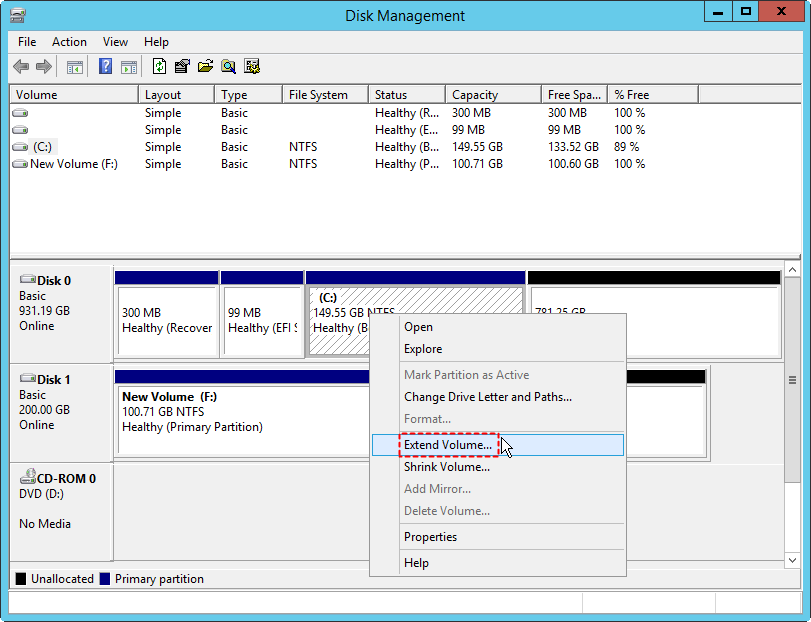
Possible error: Extend volume grayed out in Disk Management (Causes: Not an NTFS drive, no contiguous unallocated space, 2TB limit for MBR disk, unallocated space not on the same disk, etc.)
Unallocated space not at the right side of a partition?
- At the left side of a volume? For example, C D Unallocated Space E. It’s not possible to add unallocated space to the E drive using Disk Management. You can use the free tool IM-Magic Partition Resizer to add the unallocated space to E in this case.
- Right side, not adjacent to the drive? For example, C D Unallocated Space E. If you want to expand C drive with the unallocated space, you need to back up all data from D to another drive, then delete drive D in Disk Management. Or you can use IM-Magic Partition Resizer to move the D drive forward, placing the unallocated space next to the C drive.
- The recovery partition stands in the way? For example, C, recovery partition, Unallocated Space. There is no way to add the unallocated space to the C drive using Disk Management when the recovery partition or system reserved partition is involved. Third-party free tool IM-Magic Partition Resizer can help move the partitions without losing data.
Video: How to delete drive D to add unallocated space using Disk Management
#2 How to move unallocated space without losing data
Free tool IM-Magic Partition Resizer will be used in this tutorial for moving unallocated space without losing data.
Note: Moving unallocated space involves moving a partition, which changes the location of the unallocated space along with it.
Video: Move unallocated space
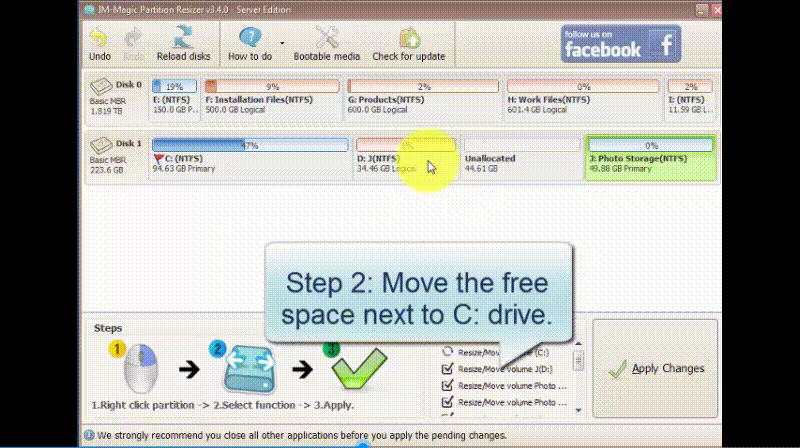
Also read: How to convert free space to unallocated space
#3 Guide: How to move free space from D partition to C drive without losing data
Step 1: Right-click a volume, here we right-click D drive to shrink free space to unallocated space as an example.
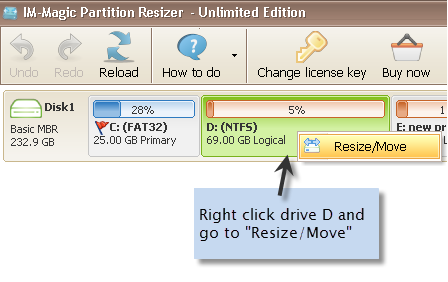
Step 2: Move the arrows to shrink the targeted partition to accumulate free space. You will notice the free space, like an unallocated volume.
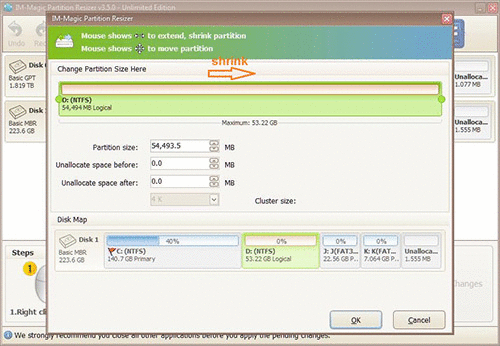

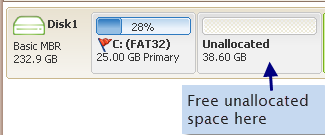
Note: Disk Management can also shrink NTFS partitions to create unallocated space (limited to NTFS partitions, not working on FAT32 partitions).
Want to move unallocated space? Free tool IM-Magic Partition Resizer can do this job while Disk Management cannot move unallocated space.
#4 Create a New Partition and Convert Unallocated Space to FAT32/NTFS
1. Create unallocated space: Deleting or shrinking a volume using freeware Partition Resizer Free or Disk Management allows you to convert free space into unallocated space.
2. Create a partition FAT32/NTFS under Disk Management or Partition Resizer by right-clicking the unallocated space, and then the create partition option will show up. 
See how to make a new partition with free space? Follow this video guide here: https://www.resize-c.com/video/
Also read: 4 ways to create a new partition
How to Turn Unallocated Space into Free Space in Windows 10 Disk Management
You can turn unallocated space into free space in Windows 10 using different methods:
1. Create a partition with the unallocated space to turn it into an available partition in Windows 10
Usually, unallocated space does not show up in My Computer in Windows 10, so you have to open Disk Management in order to see the unallocated space. In Windows 10 Disk Management, you can right-click the unallocated space and select New Simple Volume to format it into the NTFS or FAT32 file system. 
After formatting the unallocated volume successfully on Windows 10, the unallocated volume will show up as an available new partition on your computer.
2. Add unallocated space to an existing partition to get more free space on Windows 10
You can also add unallocated space to an existing partition in Windows 10 so that the existing partition will have more free space. Right-click the partition contiguous to the unallocated space and click the Extend Volume option in Disk Management.
Alternatively, you can use the free tool Partition Resizer to extend the volume by adding unallocated space to the selected partition.
Tip:
If you want to add unallocated space to the C drive in Windows 10, the unallocated space must be contiguous to the C drive. Otherwise, the extend volume shows grayed out when you attempt to add the unallocated space in Disk Management. Freeware Partition Resizer can help fix this problem.
#5 Disk Management to Convert Free Space into Unallocated Space in Windows 10?
In fact, you can also convert free space into unallocated space in Windows 10 by shrinking an existing partition in Windows 10 Disk Management. You can right-click a partition that has enough free space in Disk Management, then click the Shrink Volume option. You will get unallocated space after the partition shrinking is completed.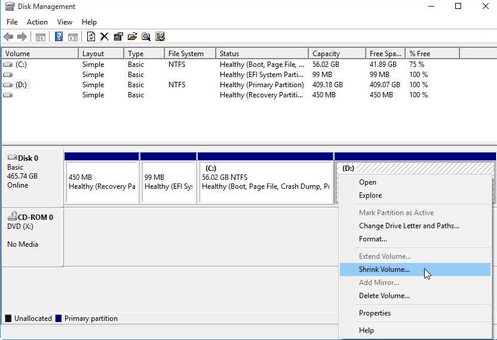
Details here: how to create and move unallocated space
Last updated on 2025/01/23